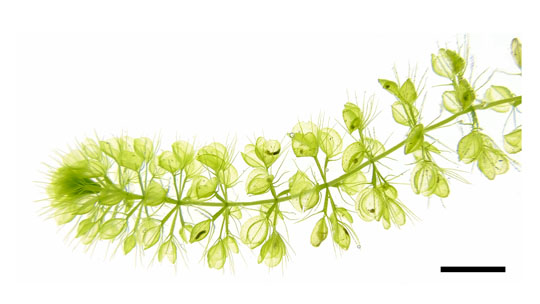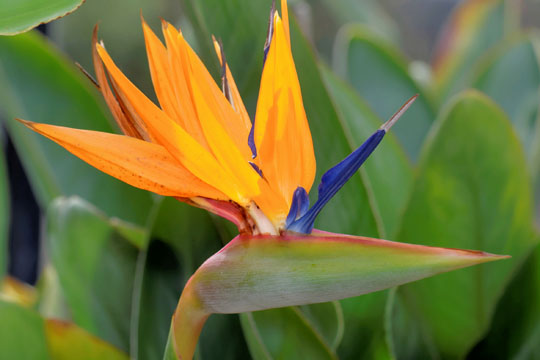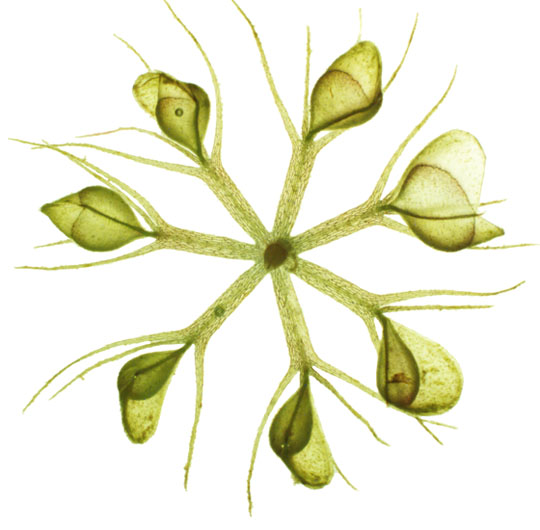Plant structures inspire cool concepts
Freiburg, Jan 02, 2018
First there was Flectofin®; now there’s Flectofold. The Plant Biomechanics Group at the Botanic Garden of the University of Freiburg was first inspired by the flowers of a bird-of-paradise plant (Strelitzia reginae). Later, they found their ideas in the carnivorous waterwheel plant (Aldrovanda vesiculosa). Using concepts from nature as a basis, the team has made progress in an already existing biomimetic approach and developed a new type of biomimetic shading device.
 Leaves form the traps: the fast traps of the carnivorous waterwheel plant inspired Freiburg researchers to analyze and abstract their motion principle for the development of a biomimetic shading system for building facades. Photo: Plant Biomechanics Group Freiburg
Leaves form the traps: the fast traps of the carnivorous waterwheel plant inspired Freiburg researchers to analyze and abstract their motion principle for the development of a biomimetic shading system for building facades. Photo: Plant Biomechanics Group Freiburg
Palatial glass structures dominate the architecture in many modern cities. Large windows let the sun in and create light and airy spaces. But with sunlight comes heat. "Air conditioning such buildings consumes an enormous amount of energy," says Dr. Simon Poppinga, a biologist. That's why a wide variety of outer shades and blinds are used to keep the heat out. Yet Prof. Thomas Speck, head of the Plant Biomechanics Group and director of the Botanical Gardens of the University of Freiburg says, "Conventional shades for facades break easily." Speck and Poppinga are biomimetics specialists. They analyse concepts and working principles in the structures and organs of organisms, predominantly in plants, and use these to develop technical solutions – such as biomimetic, kinetic shades for building facades. These are less delicate and easier to maintain than conventional shades. What is more, they are perfectly suitable for curved structures.
Weaver birds' weight opens blooms
The initial idea came from the South African bird-of-paradise plant, also known as Strelitzia reginae. Two petals of the flowers form a small cylindrical structure open on one side, the so-called perch, in which pollen and, at the base, sweet nectar, are produced. The nectar attracts the weaver birds. "In order to reach the nectar, the birds land on the petals of the flower. Their weight causes the petals to bend down and fold sideways,” says Poppinga. The “perch” opens, clearing the way to the nectar. As the birds drink, the pollen sticks to their feet and is carried to the next flower, pollinating it. Poppinga is a group leader in the Plant Biomechanics Group. While working on his doctorate, he discovered that every petal is composed of reinforced ribs connected by thin membranes. The ribs bend under the weight of the bird and the membranes automatically open. Biomimetics specialists analyse and abstract working principles, emphasizes Poppinga, "We didn't make one-to-one copies of the petals."
 The flowers of the bird-of-paradise plant provided the inspiration for Flectofin®, the first bionic shade developed by biologists at the University of Freiburg. Photo: JuergenL/Fotolia
The flowers of the bird-of-paradise plant provided the inspiration for Flectofin®, the first bionic shade developed by biologists at the University of Freiburg. Photo: JuergenL/Fotolia
"Hingeless" shades
Conventional façade shading systems are typically made of inflexible elements, often for example as horizontal slats connected to each other with joints. "There are plenty of hinges that easily jam," Poppinga says. The slats wear and finally tear, he continues. The biomimetic building shade Flectofin® doesn’t have these disadvantages. This bio-inspired system consists of single elements – like the composite bird-of-paradise petals – that stand next to each other. Upon hydraulic bending, shading membranes fold into the gaps between the Flectofin® elements to block the light, similar to the petals that fold sideways when the weaver bird sits on them. "The mechanism is reversible, because the sections and membranes are flexible," says Poppinga. If the pressure on the sections is released, the system re-opens and light again floods the rooms.
A functional, reliable principle
One of the obvious advantages of Flectofin® over conventional shading systems is that flexible sections and membranes are more durable than stiff materials and controlling them is simpler. Additionally, there aren't any joints or hinges. Plus, the vertical membranes stay cleaner because dirt does not collect on them. "The principle is functional and reliable," says Speck. Nevertheless, Poppinga and Speck weren't completely satisfied with what Flectofin® could do. "The closing mechanism required a relatively great amount of actuation force," explains Speck. So two new actors came into play: The waterwheel plant (Aldrovanda), which is carnivorous and grows under water; and biologist Anna Westermeier, who is writing her doctoral thesis on Aldrovanda. Her job is to reveal the plant's motion secrets. "The plant is truly fascinating," she says.
 The waterwheel plant's name comes from the leaves that resemble the spokes of a wheel. Photo: Plant Biomechanics Group Freiburg
The waterwheel plant's name comes from the leaves that resemble the spokes of a wheel. Photo: Plant Biomechanics Group Freiburg
Secret of speedy snap trap closure revealed
The waterwheel plant is something like a underwater miniature version of the closely related Venus flytrap (Dionaea muscipula). "Both plants develop traps that close very quickly," says Westermeier. "But waterwheel plants' traps are much smaller. They're only three millimeters long," she adds. That's more than enough to catch water fleas and to consume them. The waterwheel plant is extremely difficult to cultivate – and the jaws of its trap close at the slightest touch. That led Westermeier to build a special experimental setup for the sensitive plant. "After that we could make stereo images of its closing mechanism under fully controlled conditions," explains the biologist. The test setup needed was so big it filled a room, but it allowed all the details of the plant's trapping mechanism to be observed. Waterwheel plant traps are made of a single leaf. As soon as a flea touches one of the numerous sensitive trigger hairs inside the trap, the arthropod is doomed. The central rib of the leaf bends slightly downwards and the sides of the leaf fold, closing the trap with the flea inside.
 The new Flectofold elements are easier to fit to curved surfaces than its predecessor, Flectofin®. Photo: ITKE & ITFT
The new Flectofold elements are easier to fit to curved surfaces than its predecessor, Flectofin®. Photo: ITKE & ITFT
More elegant and easier to shape than its predecessor
The trap closes quickly and uniformly. The analysis and abstraction of the functional motion principle led to the development of the biomimetic facade shade Flectofold. Speck says that prototypes have already been built and are "in the final testing stage." Flectofold has several advantages over its predecessor Flectofin®. The material and durability extend the service life and are very likely to improve its sustainability. The shade is more elegant and also functions in geometrically distorted versions, so that "It's even easier to fit to curved surfaces," says a pleased Speck, whose working group at the Botanic Gardens is made up of 45 people. And, "Surprisingly little force is required to produce such a large movement," Speck continues. "I wish that many more biomimetic products would soon become available," says the biomimetics expert, and adds "We also want to transfer nature's beauty into product design."
Jürgen Schickinger
Partner
Prof. Dr. Thomas Speck's group carries out basic research in biology. Others were responsible for simulations, material, design, and manufacture of the bionic shades:
The Strelitzia principle developed for the Flectofin® shade through cooperation with the working groups of Prof. Dr. Markus Milwich of the Institute of Textile Technology and Process Engineering of the German Institutes of Textile and Fiber Research (DITF) Denkendorf, and of Prof. Dr. Jan Knippers of the ITKE of the University of Stuttgart. Flectofin® has already won several awards.
Flectofold was developed within the framework of the Collaborative Research Center/Transregio 141 "Biological Design and Integrative Structures." Jan Knippers, Prof. Dr. Götz T. Gresser, the head of the Institute of Textile Technology and Process Engineering at DITF Denkendorf, Prof. Dr. Manfred Bischoff of the University of Stuttgart, and all their working groups took part. Flectofold recently won the third prize at the "Industrievereinigung Verstärkte Kunststoffe (AVK)" (Industrial Association of Reinforced Plastics) 2017 AVK Innovation Awards in the "Research/Science" category.
.

